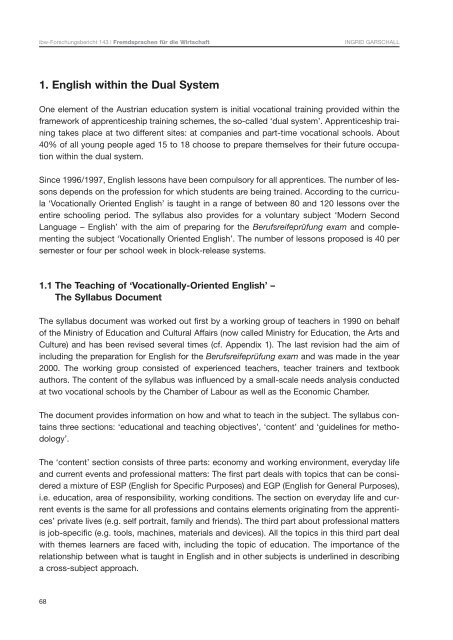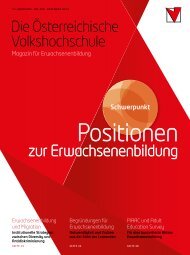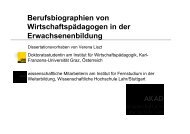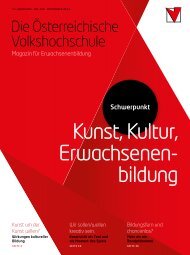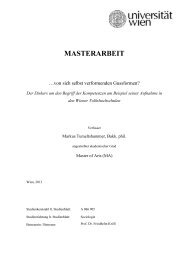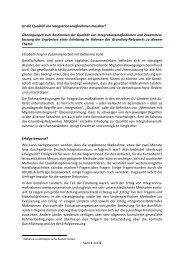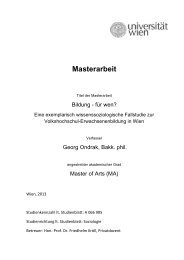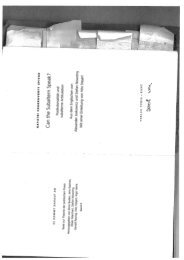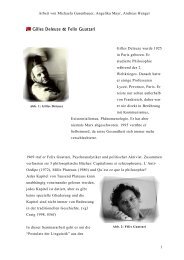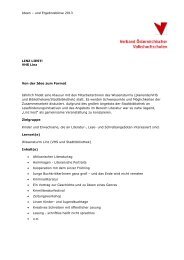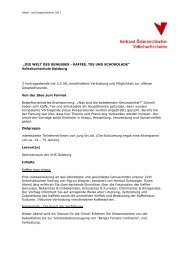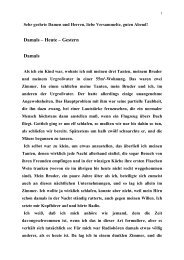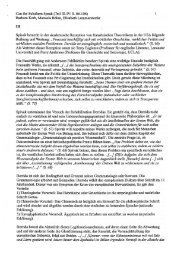Der sichere Umgang mit fremden Sprachen und Kulturen stellt heute ...
Der sichere Umgang mit fremden Sprachen und Kulturen stellt heute ...
Der sichere Umgang mit fremden Sprachen und Kulturen stellt heute ...
Erfolgreiche ePaper selbst erstellen
Machen Sie aus Ihren PDF Publikationen ein blätterbares Flipbook mit unserer einzigartigen Google optimierten e-Paper Software.
ibw-Forschungsbericht 143 | Fremdsprachen für die Wirtschaft INGRID GARSCHALL<br />
1. English within the Dual System<br />
One element of the Austrian education system is initial vocational training provided within the<br />
framework of apprenticeship training schemes, the so-called ‘dual system’. Apprenticeship training<br />
takes place at two different sites: at companies and part-time vocational schools. About<br />
40% of all young people aged 15 to 18 choose to prepare themselves for their future occupation<br />
within the dual system.<br />
Since 1996/1997, English lessons have been compulsory for all apprentices. The number of lessons<br />
depends on the profession for which students are being trained. According to the curricula<br />
‘Vocationally Oriented English’ is taught in a range of between 80 and 120 lessons over the<br />
entire schooling period. The syllabus also provides for a voluntary subject ‘Modern Second<br />
Language – English’ with the aim of preparing for the Berufsreifeprüfung exam and complementing<br />
the subject ‘Vocationally Oriented English’. The number of lessons proposed is 40 per<br />
semester or four per school week in block-release systems.<br />
1.1 The Teaching of ‘Vocationally-Oriented English’ –<br />
The Syllabus Document<br />
The syllabus document was worked out first by a working group of teachers in 1990 on behalf<br />
of the Ministry of Education and Cultural Affairs (now called Ministry for Education, the Arts and<br />
Culture) and has been revised several times (cf. Appendix 1). The last revision had the aim of<br />
including the preparation for English for the Berufsreifeprüfung exam and was made in the year<br />
2000. The working group consisted of experienced teachers, teacher trainers and textbook<br />
authors. The content of the syllabus was influenced by a small-scale needs analysis conducted<br />
at two vocational schools by the Chamber of Labour as well as the Economic Chamber.<br />
The document provides information on how and what to teach in the subject. The syllabus contains<br />
three sections: ‘educational and teaching objectives’, ‘content’ and ‘guidelines for methodology’.<br />
The ‘content’ section consists of three parts: economy and working environment, everyday life<br />
and current events and professional matters: The first part deals with topics that can be considered<br />
a mixture of ESP (English for Specific Purposes) and EGP (English for General Purposes),<br />
i.e. education, area of responsibility, working conditions. The section on everyday life and current<br />
events is the same for all professions and contains elements originating from the apprentices’<br />
private lives (e.g. self portrait, family and friends). The third part about professional matters<br />
is job-specific (e.g. tools, machines, materials and devices). All the topics in this third part deal<br />
with themes learners are faced with, including the topic of education. The importance of the<br />
relationship between what is taught in English and in other subjects is <strong>und</strong>erlined in describing<br />
a cross-subject approach.<br />
68


